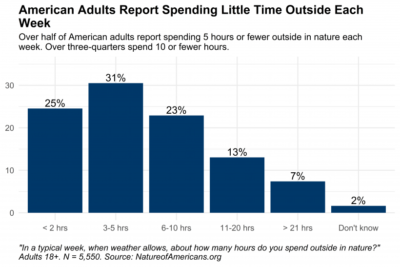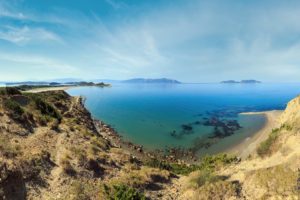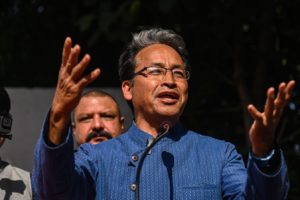Over half of American adults report spending 5 hours or fewer outside in nature each week. Over three-quarters spend 10 or fewer hours outside each week. NATUREOFAMERICANS.ORG
A survey of 12,000 adults and children in the United States has shown that many people have lost a close connection with nature, although a wide cross-section of respondents expressed a desire to close that gap.
The study, conducted by the public relations and marketing firm DJ Case and Associates in conjunction with state and federal wildlife and park agencies, underlines what many people have intuitively known for years: that the increasing use of computers, smart phones, televisions, and other technology, coupled with a growing movement from rural areas, is pulling many Americans away from the natural world. “It is increasingly normal to spend little time outside,” the report states.
The study, The Nature of Americans National Report, found that more than half of adults reported spending five hours or less in nature each week, and being satisfied with this small amount of time spent outdoors. Parents of children 8 to 12 years old said that their children spend three times as many hours with computers and televisions each week as they do playing outside.
The study said it was common for older adults who grew up in an era before computers and the Internet to lament that children are spending less and less time in the natural world. “In particular,” the report said, “older adults were concerned that younger generations are overly reliant on electronic media, unaware of how the natural world works, and unacquainted with the simple enjoyment of being outdoors.”
In addition to the lure of technology, the study said that people are spending less time in nature because places where they work, live, and go to school generally do not encourage contact with the natural world and because myriad competing priorities and activities push experiences in nature to the side. The study showed that minority groups and young adults faced more barriers to getting into nature than other groups.
Despite these discouraging trends, the study outlined numerous potential solutions to help get more Americans outdoors. The survey showed that three-quarters of adult Americans say they highly value contact with nature and support increasing the number of programs to help people appreciate nature and wildlife.
A key recommendation in the report was for communities, conservation groups, schools, and state and federal wildlife and park agencies to promote a wide variety of outdoor activities tailored to the interests of a broad cross-section of society. These would include efforts to increase participation in traditional outdoor activities — such as hunting, fishing, and hiking — as well as promoting trips to more “curated” places such as parks, gardens, zoos, and aquariums. The report said that both adults and children should be introduced to nature as a place not only for outdoor experiences, but as a place that should be conserved and cared for.
“The core premise of these recommendations is that connection to nature is not a dispensable amenity, but rather is essential to the health, economic prosperity, quality of life, and social well-being of all Americans,” the report said.
The DJ Case study builds on the work of the late Stephen Kellert of the Yale School of Forestry & Environmental Studies on the importance of spending time in nature to human health and well-being. Also involved in the study were, among others, the U.S. Fish & Wildlife Service, the Wildlife Management Institute, and state wildlife and park agencies in Texas and Florida.



